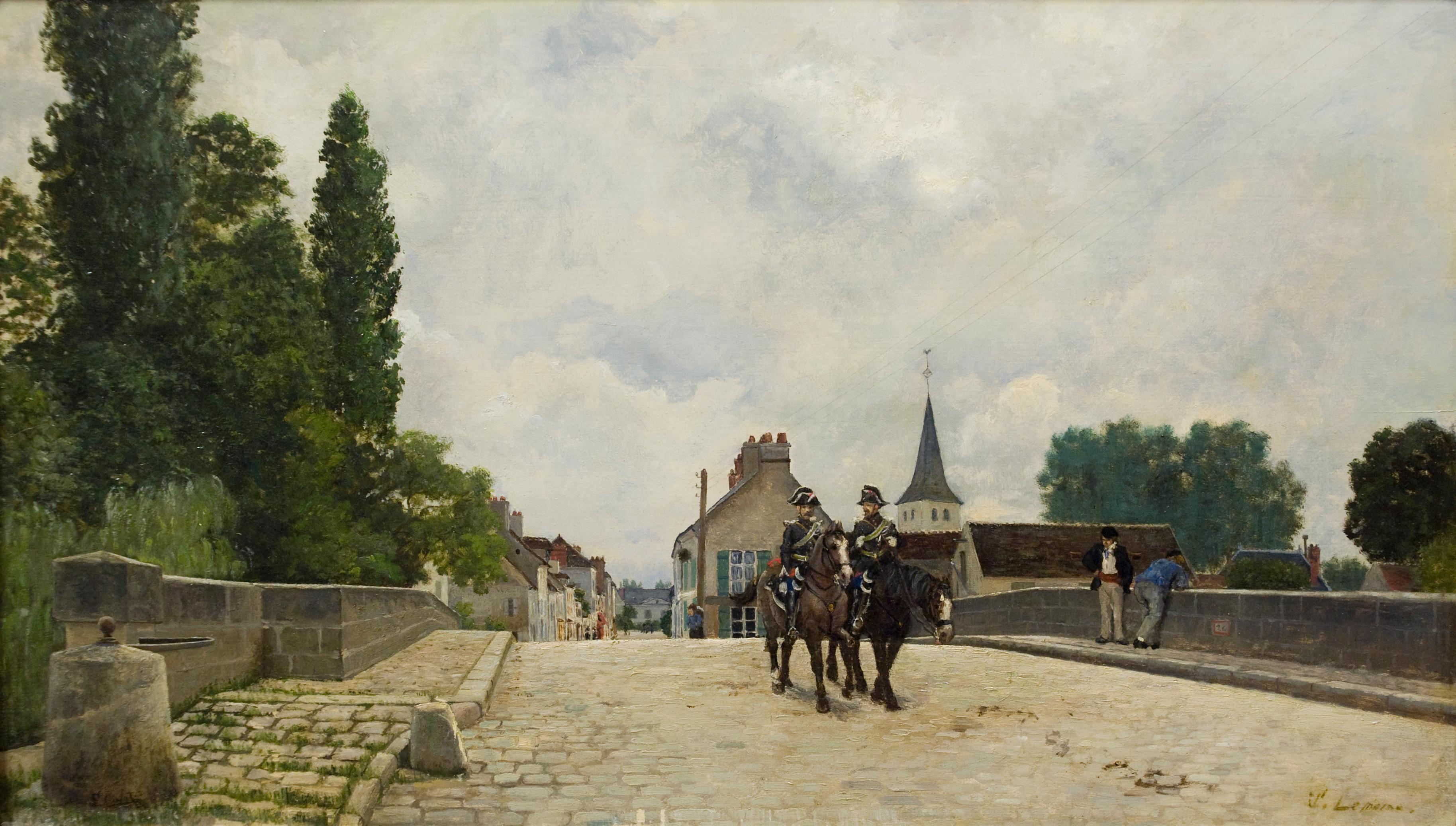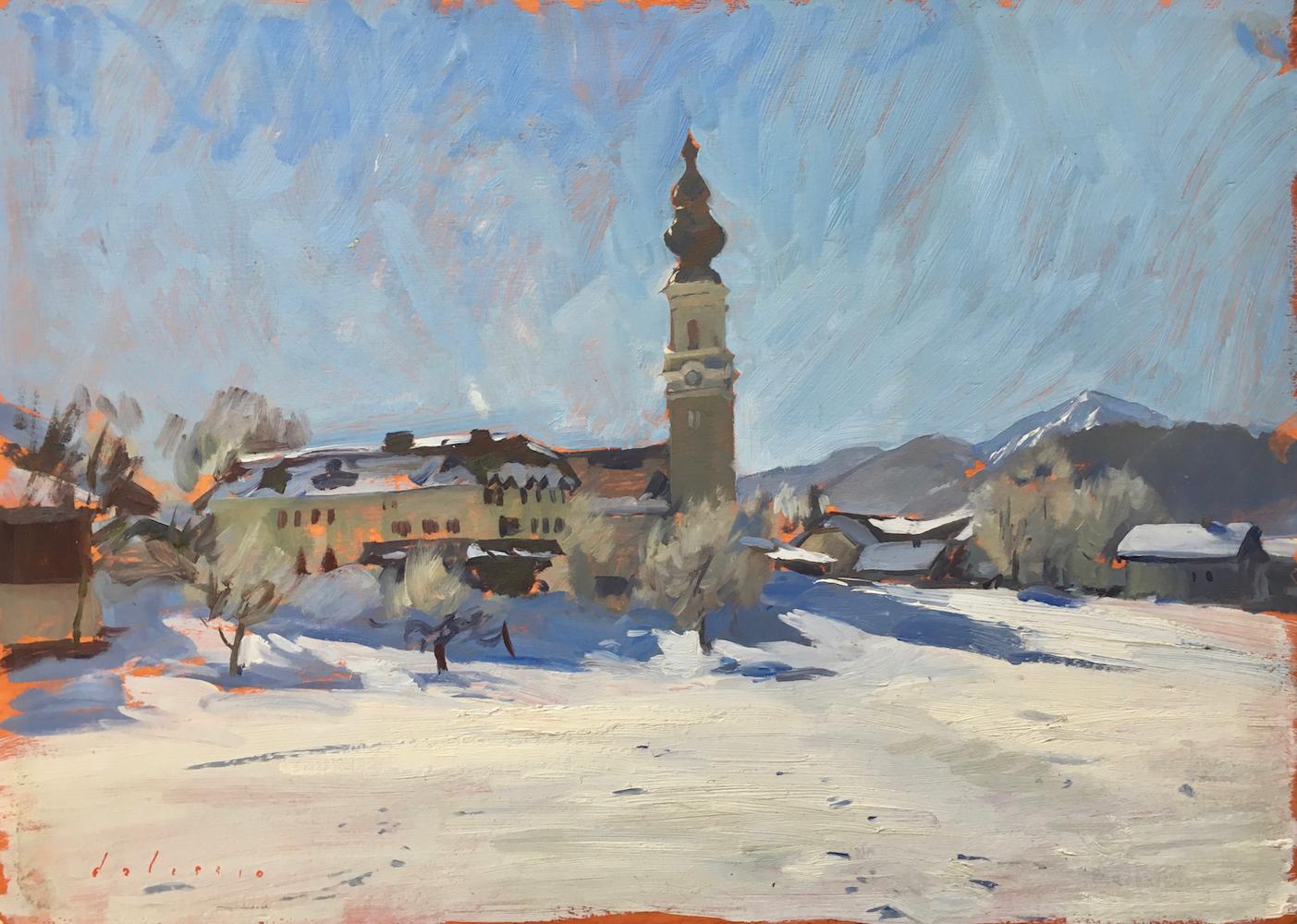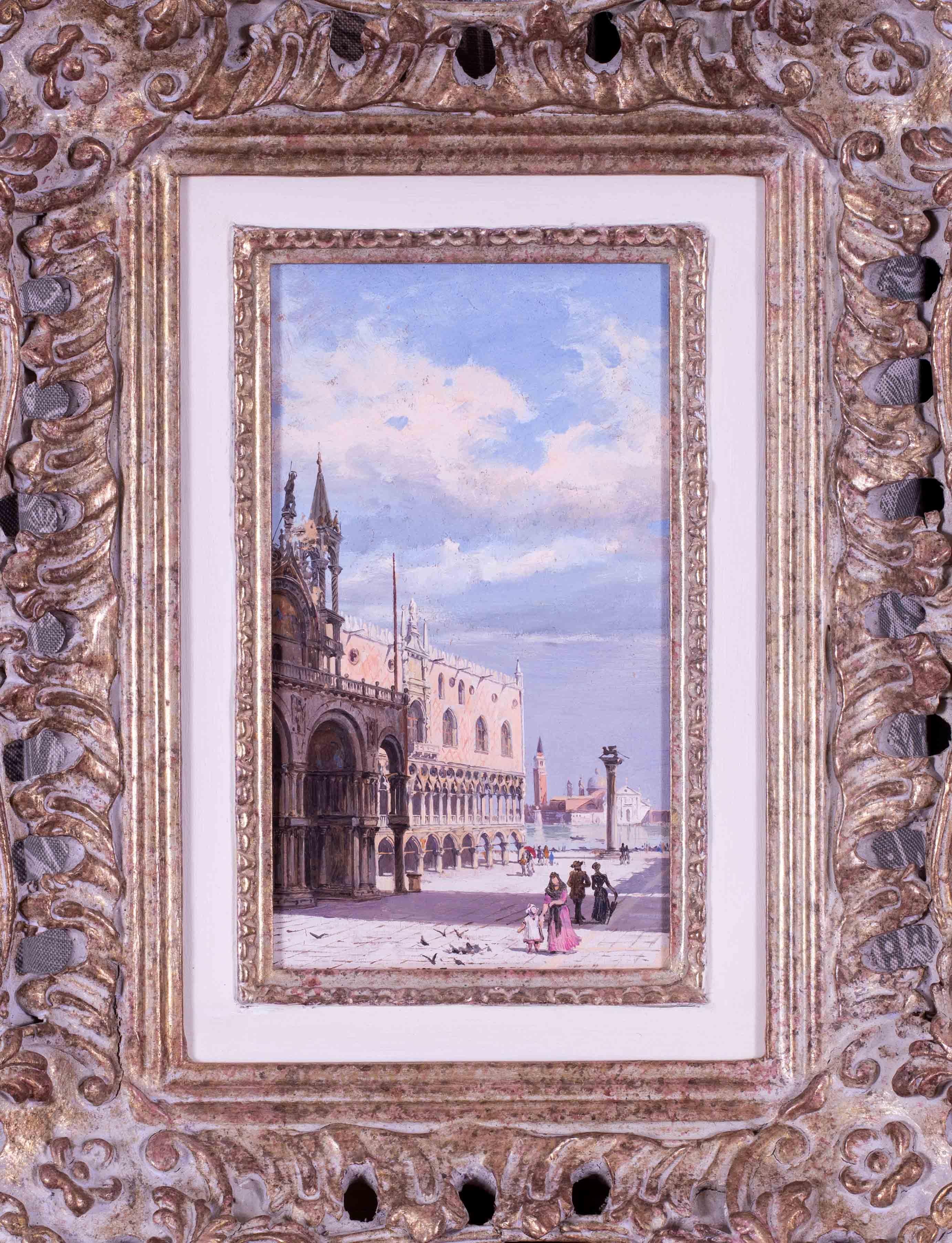Marc DalessioStony Brook Village2017
2017
About the Item
- Creator:Marc Dalessio (1972, American)
- Creation Year:2017
- Dimensions:Height: 8 in (20.32 cm)Width: 12 in (30.48 cm)Depth: 0.5 in (1.27 cm)
- Medium:
- Movement & Style:
- Period:
- Condition:
- Gallery Location:Sag Harbor, NY
- Reference Number:
Marc Dalessio
Marc Dalessio was born in 1972 in Los Angeles, California. Even in his earliest years, it was evident that his passion was art. In 1989, he started at the University of California at Santa Cruz where he focused on both art and biology. During his time in Santa Cruz, Dalessio experimented with different schools of painting and spent much of his spare time studying the history and culture of the profession. He finished his outstanding academic career, graduating from the Phi Beta Kappa Society in 1992. After university, Dalessio moved to Florence, Italy, where he spent the next eight years developing his style and refining his technique. Initially, Marc studied under Svetlan Kracsyna at Il Bisonte International School of Graphic Arts, Florence, Italy, where he earned a master printmaker degree. From there, he went on to train as a portraitist at a small traditional painting atelier. Dalessio has emerged as a true master of his craft. Whether his work depicts an Indian landscape or an Italian businessman, the lines and color in his paintings attempt to reveal the nature of his subjects. In his portraits, he works to find the essence of the model, trying to use the true character of the individual to decide the mood of the painting. His plein air landscapes, which range in subject from exotic locations around the world to his backyard, attempt to capture both the present and the history of the environment, touching the soul with his unique view of the scenery. In all his works, his dedication to light and color, and the subtlety of his subjects, enraptured even the most casual observer.
- ShippingRetrieving quote...Ships From: Sag Harbor, NY
- Return PolicyA return for this item may be initiated within 3 days of delivery.
- FaistenauBy Marc DalessioLocated in Sag Harbor, NYPlein-air landscape painting of Faistenau, in Austria. A snow covered foreground meets a structure filled horizon, a church tower reaches upward, dissecting the blue sky. Frame opt...Category
21st Century and Contemporary Academic Landscape Paintings
MaterialsPanel, Oil
- Brooklyn BridgeBy Nelson WhiteLocated in Sag Harbor, NYOil Painting of the Brooklyn Bridge, painted en plein air. A sailboat sails underneath. Painted in a thick, impressionist style. Painting dimensions: 4 x 11 inches Framed dimensions: 9 x 16 inches Framed in a handmade, Italian, custom gold leaf frame. Nelson H. White was born in New London, Connecticut in 1932. White has been surrounded by art and artists from the time he was born. He received his earliest art instruction from his grandfather, Henry Cooke White (1861-1952) and his father Nelson Cooke White (1900-1989), both important American artists. The family lived in Waterford, Connecticut and the elder White had been an early member of the art colony in Old Lyme, Connecticut. Known for his paintings of the Connecticut landscape and shoreline, Henry Cooke White became a teacher to his son, Nelson Cooke White. Living with his parents at the Florence Griswold house in Old Lyme, he met some of the most important and influential artists of the day, Childe Hassam, Will Howe Foote and Harry Hoffman. Later, Nelson White's father began to take his family to summer on Shelter Island and became friendly with many of the artists of the Peconic colony such as Irving Wiles, an important American impressionist. After graduating from the Tabor Academy in Marion, Massachusetts in 1951, Nelson H. White began to study at Mitchell College in Connecticut but left to pursue studies in the violin, musical theory and composition. At this time, he began to spend more time studying art with his father and grandfather. By 1955, Nelson H. White had decided to devote himself to a career as a painter and traveled to Florence, Italy to become an apprentice to Pietro Annigoni, the world-renowned Florentine master. Within two years, the young White had won two awards for his work. While in Florence he also studied with the great Italian teacher, Nerina Simi. Today, White divides his time between the United States and Florence. White is still actively involved with studies at The Florence Academy of Art in Florence, Italy. Although he has received instruction from some very important artists, White's work is highly individual. He paints with great spirit. Upon seeing his work one quickly senses White’s great love for nature and the outdoors. Through his eyes we are able to view and interpret nature in an intimate manner. Whether Nelson H. White is painting the Connecticut shore, a beach in Italy, a pond on Shelter Island or the hills of Vermont, he allows the observer to view a soft, yet dramatic side of nature. His ability to use color, coupled with rich brush work and a graduation of light, air and atmosphere allows one to enjoy a certain mood which is clearly conveyed in White's paintings. It is a mood that leaves us with a lasting impression. White has shown his work in numerous galleries across the globe since the 1950s, from the United States all the way to Italy and Russia. White's first museum restrospective was in the New Britain Museum of American Art in July 2012. His work can be found in many private and public collections, as well as several museums. Art Education 1999- present The Florence Academy of Art, Florence, Italy 1956-1987 Student of Ms. Nerina Simi, Florence Italy 1955-1980 Apprentice to Pietro Annigoni, Florence, Italy abd studied watercolor painting with Ogden Pleissner...Category
21st Century and Contemporary American Impressionist Landscape Paintings
MaterialsOil, Panel
- Ditch Plains LifeguardBy Marc DalessioLocated in Sag Harbor, NYPainted en plein air, on the beach (Ditch Plains) in Montauk, New York. Dalessio captures this picturesque & popular Hamptons beach. A lifeguard stand is ...Category
21st Century and Contemporary American Impressionist Landscape Paintings
MaterialsPanel, Oil
- Chianti HillsBy Marc DalessioLocated in Sag Harbor, NYPainted en plein air, in Chinati. A Vast expanse of Italian vineyards, hills and roads. Marc Dalessio was born in 1972 in Los Angeles, California. Even in his earliest years, it was evident that his passion was art. In 1989 he started at the University of California at Santa Cruz where he focused on both art and biology. During his time in Santa Cruz, Marc experimented with different schools of painting and spent much of his spare time studying the history and culture of the profession. He finished his outstanding academic career, graduating Phi Beta Kappa...Category
2010s American Impressionist Landscape Paintings
MaterialsPanel, Oil
- CarnivalBy Marc DalessioLocated in Sag Harbor, NYPainted en plein air, at Carnival, in Florence, Italy. Marc Dalessio was born in 1972 in Los Angeles, California. Even in his earliest years, it was evident that his passion was art. In 1989 he started at the University of California at Santa Cruz where he focused on both art and biology. During his time in Santa Cruz, Marc experimented with different schools of painting and spent much of his spare time studying the history and culture of the profession. He finished his outstanding academic career, graduating Phi Beta Kappa...Category
2010s American Impressionist Figurative Paintings
MaterialsPanel, Oil
- Lifting FogBy Marc DalessioLocated in Sag Harbor, NYPainted en plein air in Maine. Frame options available. Marc Dalessio was born in 1972 in Los Angeles, California. Even in his earliest years, it was evident that his passion was ...Category
2010s American Impressionist Landscape Paintings
MaterialsPanel, Oil
- Le pont de Saint Gérmain de Couilly (sur le Grand Morin)Located in Washington, DCExhibited: Salon, Société des Artistes Français, Paris, 1879 (no. 647)Category
1870s Academic Figurative Paintings
MaterialsOil, Wood Panel
- 19th Century female artist Antonietta Brandeism Piazza San Marco, VeniceBy Antonietta BrandeisLocated in Petworth, West SussexAntonietta Brandeis (Czech / Italian, 1848 – 1926) Piazza San Marco, Venice Oil on panel Inscribed with studio stamp on the reverse 8.1/4 x 4.3/4 in. (21 x 12.1 cm.) Born in the small Bohemian village of Miskowitz on January 13, 1848, Antonietta Brandeis lost her father at an early age, and probably then moved north to Prague with her widowed mother. At some point in the 1860s, she began studying painting with the Czech artist Karel Javůrek (1815-1909). Although nothing is known about the Brandeis family finances during this period, it would have been unusual for a bourgeois young woman to study painting in any serious fashion; this suggests that perhaps Antonietta’s mother was hoping to provide a marketable skill for her daughter in the world of fine art. During the 1850s-and 1860s, Prague was the center of the Czech National Revival, a cultural movement whose purpose was the rejuvenation of the Czech language as well as the reclamation of a uniquely Czech identity after centuries under the domination of the Hapsburg Empire. Brandeis’s instructor Javůrek seems to have sympathized with this movement, creating history paintings based on Czech–rather than Hapsburg–moments of significance. Brandeis studied with Javůrek for a brief period, undoubtedly learning the basics of academic painting. It is likely that he also introduced her to the artistic ideas then current in Belgium and France, having studied himself with Gustave Wappers at the Royal Academy of Fine Arts in Antwerp and with Thomas Couture at the Ecole des Beaux-Arts in Paris. This exposure to European Romanticism and Realism would have offered the young Brandeis a sophisticated understanding of contemporary aesthetic issues. In the late 1860s, Brandeis left Prague and moved to Venice with her mother, who had married a Venetian gentleman. Once there, she enrolled in the Accademia di belle arti (Academy of Fine Arts) studying with Michelangelo Grigoletti, Domenico Bresolin, Napoleone Nani, and Pompeo Marino Molmenti, all of whom were mainstream academic painters. She graduated in 1872 with a number of honors to her credit, and a Premio award in landscape painting. According to the listing in the Atti della reale Accademia di belle arti in Venezia dell’anno 1872, Brandeis was one of only two women graduating that year, the other being Carolina Higgins, an English woman. The admission of women to officially sponsored fine arts academies in Europe and the US was rare in the 1870s, and enrollment in life classes where nude models posed was almost universally unacceptable for female students. The fact that Brandeis and Higgins seem to have been the only women at the Accademia in the early 1870s tends to suggest that they participated in the same classes as their male classmates. In fact, Brandeis is cited for an award in the “study of the nude”. After graduation, Brandeis began to establish a career as a landscape painter in Venice. In 1873, she showed four paintings at the annual November exposition at the Accademia; these included one portrait, two landscapes, and one vedute of the Grand Canal that was commissioned by an English woman. Although there is no record of who this English woman was, it is tempting to think that she may have been someone Brandeis met through her classmate Carolina Higgins. Over the next few decades, Brandeis seems to have exhibited regularly at the annual Accademia shows, but her primary focus was increasingly on painting Venetian scenes (vedute) that appealed to the always plentiful crowd of visitors to Venice. She specialized in relatively small scale paintings of landmarks in her adopted city, and gradually became part of a community of expatriate artists who shared this interest. Among her friends were the Peruvian artist Federico de Campo and many of the Spanish artists then living in Venice such as Mariano Fortuny, Martin Rico and Rafael Senet. It should be noted too that by the end of the nineteenth century, Venice had become a regular stop for any painter who was particularly fascinated with color and light. Some, like the Americans Walter Gay and John Singer Sargent, spent months or even years living there, and others simply made regular visits, such as Pierre-August Renoir and Claude Monet. However, nearly all painters who traveled through Europe made at least one journey to see Venice’s unique environment. More important for painters like Brandeis were the travelers who came as tourists and wanted a souvenir to take home with them. By the late nineteenth century the aristocratic tradition of the Grand Tour had been considerably democratized by the industrial revolution, which had not only created a newly wealthy merchant class, but had provided the railroad as a means of convenient travel across long distances. Venice was no longer the exotic province of the European aristocracy, but a city that lured bourgeois romantics from all over the world. Brandeis’s images of the city were especially popular with Austrian and English visitors. Brandeis also painted at least three known altarpieces, all for churches in what is today southern Croatia. In the late 1870s when she received the initial commission, the Dalmatian coast of Croatia had trading and cultural ties to Italy dating back to the Roman Empire; however, it was the region surrounding the Republic of Venice that was most influential in the nineteenth century. During this time, the new bishop of Split (Spoleto), Marko Kalogjera, was actively involved in building new churches in Croatia as well as updating the older ones, and it is likely that he was instrumental in hiring Venetian painters for a variety of commissions. In fact, Michelangelo Grigoletto, one of Brandeis’s instructors at the Accademia, had earlier received a commission for a painting in a parish church in the town of Vodice. Given the remote location, it is not surprising that Bishop Kalogjera would turn to Venice when hiring artists for major projects in the towns of Blato and Smokvici. The religious traditions of Venetian painting are clearly evident in Brandeis’s Madonna and Child with St. Vitus at the Church of St. Vitus in Blato. The composition is based on the tradition of the sacra conversazione (sacred conversation) between the Virgin Mary and the saints. In this image, Brandeis presents not only St. Vitus, but also a young man who is apparently suffering from one of the illnesses that the saint was known to cure. The large canvas is surrounded by architectural elements above the altar and creates a dramatic statement as worshippers look up at the elegant Madonna. Brandeis also created two paintings for the church of Our Lady of Carmel in the neighboring town of Smokvici. One features another sacra conversazione, this time with St. Lucia, St. Anthony of Padua and St. Roch. The other is an altarpiece showing the Presentation of Christ in the Temple. These three large scale paintings must have been started in 1879 or 1880 and probably finished several years later. Concurrent with the major altarpiece commissions, Brandeis continued to produce many vedute for travelers in Venice. She also made a number of trips to Florence, Bologna and Rome where she painted cityscapes of the architectural and urban scenes featuring classical and renaissance motifs. The popularity of her work was further enhanced by the production of chromolithographs of her paintings, probably beginning in the late 1880s or 1890s. She expanded her market even further in 1880 when she exhibited three paintings at the International Exposition in Melbourne. In her personal life, Antonietta married Antonio Zamboni on October 27, 1897; Zamboni was a knight of the Order of Saints Maurizio and Lazzaro, originally founded by the Duke of Savoy in 1572, but closely affiliated with the newly united Kingdom of Italy in the late nineteenth century. Brandeis’s enthusiasm for Venice seems to have waned somewhat by 1900 when she was quoted as saying that she was still “a foreigner” in Venice, and she no longer participated in any Italian exhibitions, but sent all of her paintings to London. [v] Brandeis’s early association with English collectors seems to have evolved into a relationship that served her well for many decades. Nonetheless, she remained in Venice until the death of her husband in 1909, at which time she moved to Florence. The full story of Antonietta Brandeis’s life remains unknown, but she seems to have been a woman who challenged social conventions on many levels: as a woman studying in an almost exclusively male academy...Category
19th Century Academic Landscape Paintings
MaterialsPanel, Oil
- View over the Roof-tops of Frederiksborg Castle, DenmarkBy Svend HammershøiLocated in New York, NYSvend Hammershoi (1873 Frederiksborg, Copenhagen 1948), View over the Roof-tops of Frederiksborg Castle, Denmark, Oil on Panel, Signed: SH, in it's original frame "Designer, painter and trained ceramicist, Svend Hammershøi was the younger brother of Vilhelm Hammershøi...Category
Early 20th Century Academic Paintings
MaterialsOil, Panel, Paint
- La Rentrée du Troupeau en Plaine de BarbizonBy Jean Ferdinand CHAIGNEAU 1Located in Atlanta, GAJean-Ferdinand Chaigneau was born in the shipping center of Bordeaux on March 6th, 1830. There he studied drawing under the academic painter Jean-Paul Alaux (1788-1858). In 1847...Category
19th Century Academic Landscape Paintings
MaterialsPanel, Oil
- Bergère près des rochersBy Jean Ferdinand CHAIGNEAU 1Located in Atlanta, GAJean-Ferdinand Chaigneau was born in the shipping center of Bordeaux on March 6th, 1830. There he studied drawing under the academic painter Jean-Paul Alaux (1788-1858). In 1847...Category
19th Century Academic Landscape Paintings
MaterialsOil, Panel
- Bergère et son troupeau crépuscule, plaine de BarbizonBy Jean Ferdinand CHAIGNEAU 1Located in Atlanta, GAJean-Ferdinand Chaigneau was born in the shipping center of Bordeaux on March 6th, 1830. There he studied drawing under the academic painter Jean-Paul Alaux (1788-1858). In 1847...Category
19th Century Academic Landscape Paintings
MaterialsOil, Panel






